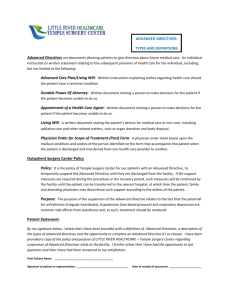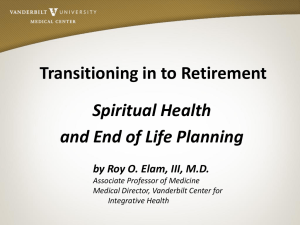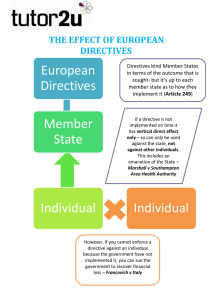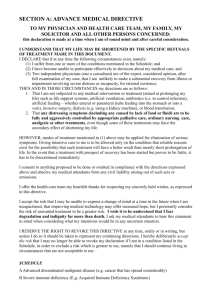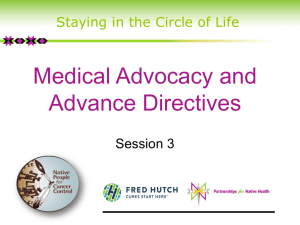Myths and Facts About Health Care Advance Directives
advertisement
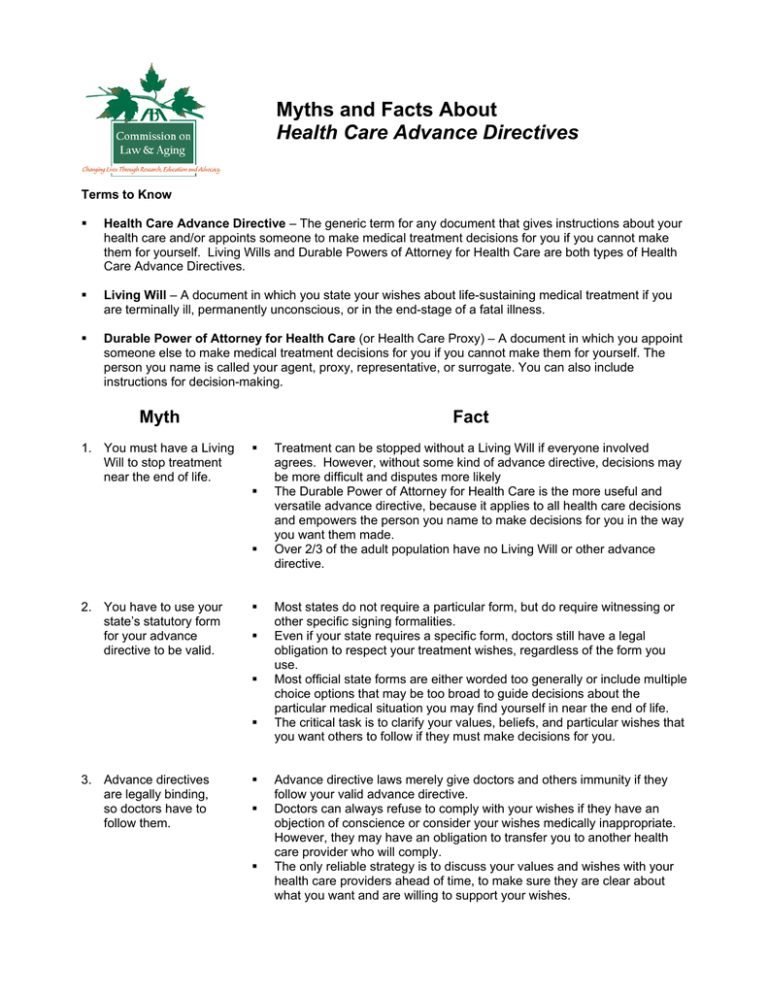
Myths and Facts About Health Care Advance Directives Terms to Know Health Care Advance Directive – The generic term for any document that gives instructions about your health care and/or appoints someone to make medical treatment decisions for you if you cannot make them for yourself. Living Wills and Durable Powers of Attorney for Health Care are both types of Health Care Advance Directives. Living Will – A document in which you state your wishes about life-sustaining medical treatment if you are terminally ill, permanently unconscious, or in the end-stage of a fatal illness. Durable Power of Attorney for Health Care (or Health Care Proxy) – A document in which you appoint someone else to make medical treatment decisions for you if you cannot make them for yourself. The person you name is called your agent, proxy, representative, or surrogate. You can also include instructions for decision-making. Myth 1. You must have a Living Will to stop treatment near the end of life. Fact 2. You have to use your state’s statutory form for your advance directive to be valid. 3. Advance directives are legally binding, so doctors have to follow them. Treatment can be stopped without a Living Will if everyone involved agrees. However, without some kind of advance directive, decisions may be more difficult and disputes more likely The Durable Power of Attorney for Health Care is the more useful and versatile advance directive, because it applies to all health care decisions and empowers the person you name to make decisions for you in the way you want them made. Over 2/3 of the adult population have no Living Will or other advance directive. Most states do not require a particular form, but do require witnessing or other specific signing formalities. Even if your state requires a specific form, doctors still have a legal obligation to respect your treatment wishes, regardless of the form you use. Most official state forms are either worded too generally or include multiple choice options that may be too broad to guide decisions about the particular medical situation you may find yourself in near the end of life. The critical task is to clarify your values, beliefs, and particular wishes that you want others to follow if they must make decisions for you. Advance directive laws merely give doctors and others immunity if they follow your valid advance directive. Doctors can always refuse to comply with your wishes if they have an objection of conscience or consider your wishes medically inappropriate. However, they may have an obligation to transfer you to another health care provider who will comply. The only reliable strategy is to discuss your values and wishes with your health care providers ahead of time, to make sure they are clear about what you want and are willing to support your wishes. 4. An advance directive means “Do not treat.” An advance directive can express both what you want and don’t want. Never assume it simply means “Do not treat.” Even if you do not want treatment to cure you, you should always be kept reasonably pain free and comfortable. 5. If I name a health care proxy, I give up the right to make my own decisions. Naming a health care proxy or agent does not take away any of your authority. You always have the right, while you are still competent, to override the decision of your proxy or revoke the directive. If you do not name a proxy or agent, the likelihood of needing a courtappointed guardian grows greater, especially if there is disagreement regarding your treatment among your family and doctors. 6. I should wait until I am sure about what I want before signing an advance directive. No. Most of us have some ambivalence about what we would want, and that’s OK, because treatment near the end of life can be complicated. We can’t predict all the facts and circumstances that may face us in the future, and treatment wishes may change. You can, at least, appoint your proxy if you have someone whom you trust. 7. Just talking to my doctor and family about what I want is not legally effective. Meaningful discussion with your doctor and family is actually the most important step. The question of what is “legally effective” is misleading, because even a legally effective document does not automatically carry out your wishes. The best strategy is to use a good health decisions workbook to help you clarify your wishes; talk with your physician, health care agent, and family about your wishes; put those wishes in writing in an advance directive; and make sure everyone has a copy. 8. Once I give my doctor a signed copy of my directive, my task is done! No, you have just started. First, make sure your doctor understands and supports your wishes. Second, there is no guarantee that your directive will follow you in your medical record, especially if you are transferred from one facility to another. You or your proxy should always double-check to be sure your providers are aware of your directive and have a copy. Advance planning is an ongoing PROCESS. Review your wishes yearly or anytime your health or family status changes, make appropriate changes, and communicate those changes as needed. 9. If I am living at home and do not want to be resuscitated by an EMS team if my heart or breathing stops, my advance directive must say so. Your advance directive will usually not help in this situation. If someone dials 9-1-1, EMS must attempt to resuscitate you and transport you to a hospital, UNLESS you have a special out-of-hospital DNR form or bracelet used in your state. This is not the same as your health care advance directive. In most states, both the patient and doctor must sign the special form and the patient then wears a special identification bracelet or necklace. 10. Advance directives are only for old people. It is true that more older, rather than younger, people use advance directives, but every adult should have one. Younger adults actually have more at stake, because, if stricken by serious disease or accident, medical technology may keep them alive but insentient for decades. Some of the most well-known “right to die” cases arose from the experiences of young people (e.g., Karen Ann Quinlan, Nancy Cruzan) incapacitated by tragic illnesses or car accidents and maintained on life support. American Bar Association Commission on Law and Aging 740 Fifteenth Street, NW, Washington, DC 20005 Ph: 202-662-8690 Internet: www.abanet.org/aging
